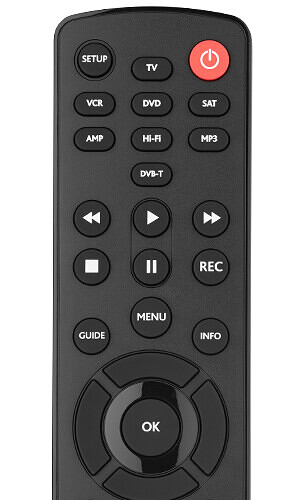So I got a Vero 4K from eBay for £45 the other day. Very impressive! Basically the least amount of config I’ve needed to do to get a good performance from Kodi and doesn’t hitch at all on 4K content even when transcoding to AC3 for my old 5.1 style amp.
I’ve already got my customised/slightly tweaked version of Confluence on there as a preferred skin, now the challenge remains in getting a remote layout I’m happy with.
Credit where it’s due, the default OSMC remote layout is very good; even the long presses make a lot of logical sense to me from a usability standpoint, certainly better than the Apple TV style or original Xbox (yep; I’ve been using Kodi since it was XBMC circa 2008). But it just doesn’t have enough buttons, for example to make a persistent “Favourites anywhere” feature, so I’d like to get some kind of universal remote system sorted for it.
Now I do have some choices. First of all, Harmony remotes are out - I have an old Harmony 400 lying around somewhere that I never got on with, something to do with inter-key delay and needing to use that terrible software to configure it. I much prefer the JP1 style remotes and have a couple of One For All variants of this - the older URC7960 and the newer URC1280, plus a FLIRC v1 dongle I used to use to control Kodi on a Fire TV. To control XBMC/Kodi I’ve usually used the original Xbox DVD dongle IR, either on Xbox controller port or with Windows 7 and 10 via a USB adapter and specialist XBCDRC driver plus Eventghost. Has worked great for years.
Tried the Xbox DVD dongle in My OSMC without any luck; won’t pick up any IR input from the remotes using code 0522. I did have some success using the Xbox 360 MC remote via code 1708 although input seems a little sluggish with or without the IR extender, which from what I’ve read on the forums here is a bit of an Achilles heel of the Vero - bluetooth/RF are better being the general consensus.
What I’d like to do is find a way to “teach in” some IR commands via the irremote feature, edit the keymap XML(s) as needed, and see how I get on. Basically I’m not overly fussed which IR solution works here - which JP1 remote code or FLIRC - as long as the solution is reliable, not overly laggy and allows me to assign short and long presses as needed for various functions (like short press info button on remote = standard Kodi info function and long press info on remote = jump directly to System Info, stuff like that).
So, to cut a long first post short, any pointers on the best way to go about things here would be appreciated. I know I need to SSH in and kill Kodi (mediacentre process or whatever it’s called via command line) but I can’t seem to find the forum post I was reading in the wee small hours of the morning earlier.
Thanks in advance! The Vero 4K is looking like THE Kodi box, so far, and I’ve been through enough of them to know (original Xbox, Fire TV, Apple TV 4, three media centre PCs running Windows 7 or Windows 10… probably more) just need to get a working method to customise the remote and I’ll be very happy with this setup, relegating my third HTPC to just being a media server for OSMC boxes instead. 





 coloured buttons as short cuts (TV shows by title/Movies by title/Videos by folder (for non-library content)/Music by folder) and then repurposing those in FullscreenVideo (Audio delay/Subtitle Delay/Video options/Audio options). I’ve been using Kodi this way for years and it’s very quick and efficient; stuff like being able to hold down the record
coloured buttons as short cuts (TV shows by title/Movies by title/Videos by folder (for non-library content)/Music by folder) and then repurposing those in FullscreenVideo (Audio delay/Subtitle Delay/Video options/Audio options). I’ve been using Kodi this way for years and it’s very quick and efficient; stuff like being able to hold down the record  button to trigger an OpenSubtitle search and automatic download saves messing around in menus for 20 seconds when trying to watch and is basically a godsend!
button to trigger an OpenSubtitle search and automatic download saves messing around in menus for 20 seconds when trying to watch and is basically a godsend!